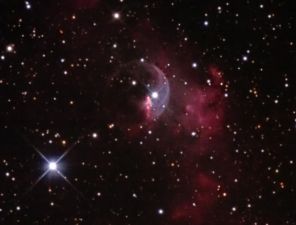

Description, also known as the Bubble Nebula, Sharpless 162, or Caldwell 11, is a H II region[2] emission nebula in the constellation Cassiopeia
Image data: 9 images of 120 seconds integration time were combined. Canon 50d, sRAW, ISO 1600, 12" Newton, F/6, Paracorr, 2010/10/10.
Planetary Nebulae
Planetary nebulae are a short-lived phase of a low mass stars evolution ( < 8 solar masses). During this stage, the matter loss on the asymptotic giant branch in the HRD, will be visible as an ionized shell surrounding the PN's central star, which later on will become a white dwarf, while the ring material will disperse into the interstellar medium, enriching it with heavier elements. The star contributes in this way to the chemical evolution of the galaxy. Roughly 1500 PNs are known to date in our own Galaxy.
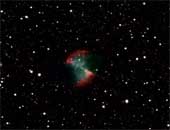
M27, Planetary nebula in Vulpecula
Image data: Two images in R,G,B of 600 seconds integration time, L-Frame combined RGB, ST-8E, 120 f/5 Refractor, 08/24/03, 1530x1020 jpeg 164k
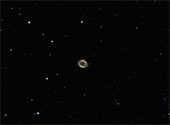
Image data: Two images in R,G of 300 seconds, and 4 in B of 500 seconds integration time, L-Frame combined RGB, ST-8E, 120 f/5 Refractor, 08/16/03, 1530x1020 jpeg 60k
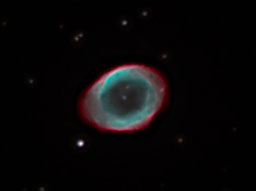 Ring Nebula, Canon 50d, sRAW, ISO 1600, 12" Newton, F/6, Paracorr, 2010/10/10. Description
Ring Nebula, Canon 50d, sRAW, ISO 1600, 12" Newton, F/6, Paracorr, 2010/10/10. Description
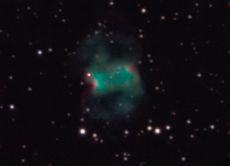 M76, Canon 50d, sRAW, ISO 1600, 12" Newton, F/6, Paracorr, 2010/10/10. Description
M76, Canon 50d, sRAW, ISO 1600, 12" Newton, F/6, Paracorr, 2010/10/10. Description
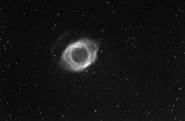
Helix Nebula (NGC 7293), large planetary nebula in Aquarius
Image data: Two images in H-alpha 600 seconds each, ST-8E, 120 f/5 Refractor, 08/24/03, 1530x1020 jpeg 179k
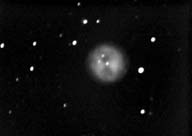 M97, Owl nebula in Ursa Major,12/17/98,
jpeg, 20k
M97, Owl nebula in Ursa Major,12/17/98,
jpeg, 20k
The following image shows NGC 7008. Standing high in the summer sky, it was obtained on August 18, 1998.
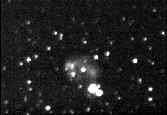 ,NGC 7008, planetary nebula in Cygnus, 08/18/98 jpeg, 17k
,NGC 7008, planetary nebula in Cygnus, 08/18/98 jpeg, 17k
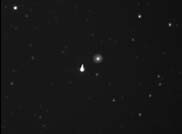 NGC 2392, planetary nebula in Gemini,
12/17/98, jpeg 8k
NGC 2392, planetary nebula in Gemini,
12/17/98, jpeg 8k
This is the famous Eskimo Nebula, smaller than expected and the face can
not be recognized.
Wolf-Rayet Nebula
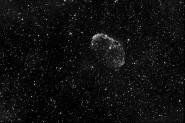 NGC
6888 Wolf-Rayet Nebula in Cygnus
NGC
6888 Wolf-Rayet Nebula in Cygnus
Image data: Refractor 120 f/5, H-alpha, five images of 600sec each, ST8-E,
1530x1020, 08/21/03, jpeg 184k
Lightecho V838-Monocerotis
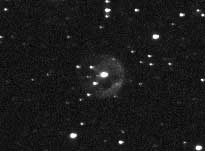
V838 Mon, eruptive star in Monoceros,
10" f/4.5 Newton, ST8E, 01/09/03,jpeg, 61k
Among the most mysterious stars found is the variable star V838 Monocerotis.
The unusual outburst of V838 Mon was discovered in January, 2002 by an
amateur astronomer in Australia. First interpreted as a classical nova,
astronomers quickly realized that instead, V838 Mon may be an extremly
rare speciman in the astronomical zoo. First, it brightened about a hundredfold,
then it faded slowly before erupting to around ten thousand times its original
brightness. The observed transformation conflicts the conventional understanding
of stellar life cycles. The most notable feature of V838 Mon is the rapidly
"expanding" nebula surrounding it. The imaged nebula is a light echo from
shells of formerly unseen material ejected by the star in previous evolutionary
stages. Light-years in diameter, the shells progressively reflect the light
from V838 Mon's outbursts, providing an opportunity to look back at the
history of this remarkable star's behaviour. The echo is due to light from
the eruption bouncing off dust surrounding the star and getting scattered
towards us. If we assume that these are dust shells are centred on the star,
we can estimate V838 Mon's distance from the rate at which the echo has
grown. In this way, we calculate that the star is about 6000-8000 light
years away.
Gas, Dust and Dark Nebulae
Crucial to our understanding of star formation is a knowledge of the interstellar gas and dust from which new generations of stars are born. During the 1970s, astronomers learned that the interstellar medium in our own galaxy has both hot and cold components. Some gas is as hot as 1,000,000K, some is in the form of dense molecular clouds at temperatures near 10K. New instruments in the millimeter and infrared spectral regions have permitted astronomers to probe these cold birthplaces of stars. The cocoons of gas and dust contract under their own gravity, warming as they collapse, until their core temperatures become high enough to initiate nuclear fusion; a protostar or a cluster of protostars is born.
There is some evidence that supernova explosions from dying stars compress the clouds , initiating a new generation of star births. Both spatial and temporally, star formation appears sequential, with new generations arising at the outer edges of older associations. The roles played by magnetic fields, rotation and turbulence and the factors that control single or multiple births are not known. Like the sun, some stars retain a disk or a complex pattern of debris after their formation. Such stars are candidates for associated solar systems.
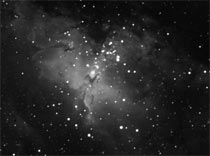 M16, Eagle nebula, Open
star cluster, gas and dust in Serpens
M16, Eagle nebula, Open
star cluster, gas and dust in Serpens
Image data: Refractor 120 f/5, Astronomik H-alpha (13nm), ST8-E, 1530x1020,
08/21/03, jpeg 171k
debris after their formation. Such stars are candidates for associated
solar systems.
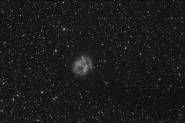 IC 5146, Cocoon
nebula, emission nebula in Cygnus
IC 5146, Cocoon
nebula, emission nebula in Cygnus
Image data: Refractor 120 f/5, five exposures 600sec each, H-alpha, ST8-E, 1530x1020, 09/03/03, jpeg 211k
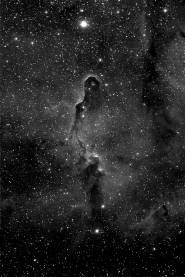 vdB142, Dark Nebula as part
of IC1396 in Cepheus
vdB142, Dark Nebula as part
of IC1396 in Cepheus
Image data: Refractor 120 f/5, three exposures 600sec each, H-alpha, ST8-E, 1530x1020, 08/26/03, jpeg 286k
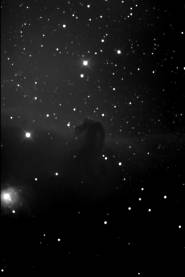
You will hardly find a copy of Sky & Telescope where this this
nebula is not shown in the image section. It is therefore interesting
to note that it was discovered as late as 1888, because, as every visual
observer of deep-sky-objects knows, it takes a very dark sky for
a successful observation. The Horsehead is a dark nebula, seen against
the brighter background of hydrogen gas, energized by Sigma Orionis,
a bright hot star, southwest of Zeta Orionis the leftmost
of the stars in Orion's belt. (See below)
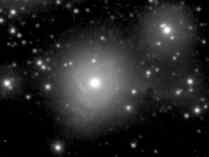 Zeta Orionis and the region of the horse
head and the flame nebula, LcCCD14, 105 mm F/2.5, jpeg, 20k
Zeta Orionis and the region of the horse
head and the flame nebula, LcCCD14, 105 mm F/2.5, jpeg, 20k
This is a really brilliant star (the left one in Orion's belt)
as some data from the Hipparcos catalog emphasize:
Spectral type O9.5Ib SB, distance 820 (+/- 150) light years,
luminosity: 10500 (+/- 3900) solar, absolute Mag: -5.26 (+/- 0.40).
The star heats it's surrounding gas and dust by intense ultra violet
radiation.
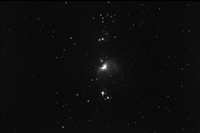 M42, Nikon telelens 200mm f/4, ST8E,
01/25/00, jpeg 45k
M42, Nikon telelens 200mm f/4, ST8E,
01/25/00, jpeg 45k
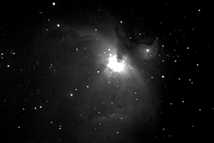 Orion Nebula (M42), Newton 8" f/4.6,
ST8E, 01/11/00, jpeg 34k
Orion Nebula (M42), Newton 8" f/4.6,
ST8E, 01/11/00, jpeg 34k
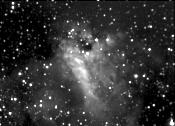 M17, Omega or Swan Nebula in Sagittarius,
8" f/4.6, 05/24/99, jpeg, 32k
M17, Omega or Swan Nebula in Sagittarius,
8" f/4.6, 05/24/99, jpeg, 32k
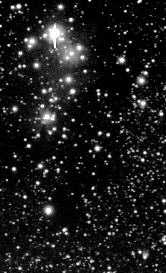 Cone (NGC 2264) and Hubble's Variable Nebula (NGC 2261) in Monocerus,
tele lens Nikon 200mm f/4, ST8E, 02/25/00, jpeg 13k
Cone (NGC 2264) and Hubble's Variable Nebula (NGC 2261) in Monocerus,
tele lens Nikon 200mm f/4, ST8E, 02/25/00, jpeg 13k
8 images, 100 seconds integration, darks and flats.
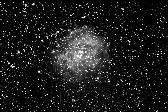 Rosetta nebula, Diffuse nebula in
Monocerus, 12/17/98, jpeg, 91k
Rosetta nebula, Diffuse nebula in
Monocerus, 12/17/98, jpeg, 91k
The image shows the diffuse nebula surrounding the open cluster NGC2244. The nebula itself is very faint, but the central cluster is visible in binoculars. It has an angular diameter of 80 arcmins, and so it is much larger than the Moon, but it has a true diameter of around 55 light-years and a distance of approximately 2,600 light-years.
Besides the interstellar debris, supernova explosions often leave behind a
cinder, the star's dense, collapsed neutron core, which was created by the compression
of electrons and protons. Called a neutron star, the object is about 10 - 20
km wide, has a mass greater than our Sun, and a density of about 10000000 tons
per cubic centimeter. Because of its small size and high density, the
neutron star possesses a gravitational field 300,000 times stronger than the
Earth's. Its rotation also increases dramatically during the collapse.
Most celestial objects rotate, but neutron stars rotate very rapidly.
The neutron star in the Crab Nebula rotates 30 times per second or 5.5 million
kilometers per hour. It is the only kind of star that can rotate so rapidly
without breaking apart.
See the VRML-Model
of an exploding supernova, study the core collapse and the formation of a new
pulsar.
A wider view, 12inch Newton, Canon 50d, 2011
M1, the Crab Nebula, was the first object on Messier's list of nebulous objects. It is a relic of the supernova from 1054, which was observed by Chinese astronomers. Beside the expanding gas shell, the supernova produced a rapidly rotating neutron star, a pulsar. The small star at the indicated position is the most energetic pulsar known. As pulsars age, their rapid rotation slows. This gradual slowdown powers all kinds of emissions. Astronomers define the spin-down luminosity of a pulsar as the rate at which the star loses its kinetic energy of rotation. By this measure the most energetic pulsar is the one above. Spinning once every 0.033 second, the Crab pulsar is loosing 100000 times more energy than the sun radiates!
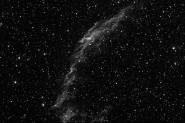
NGC 6992, Part of the Veil
Nebula, another well studied SNR in Cygnus
Image data: Refractor 120 f/5, three exposures 600sec each, H-alpha, ST8-E, 1530x1020, 08/21/03, jpeg 178k
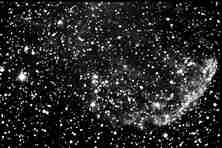 IC443, Supernova remnant in Gemini,
01/28/00, 8" f/4.6, jpeg 62k
IC443, Supernova remnant in Gemini,
01/28/00, 8" f/4.6, jpeg 62k
Comments welcome, contact:
